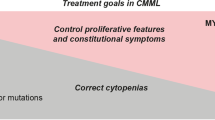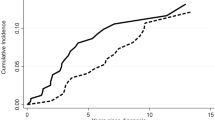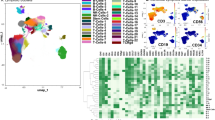Abstract
Failure to undergo activation-induced cell death due to global dysregulation of apoptosis is the pathogenic hallmark of large granular lymphocyte (LGL) leukemia. Consequently, immunosuppressive agents are rational choices for treatment. This first prospective trial in LGL leukemia was a multicenter, phase 2 clinical trial evaluating methotrexate (MTX) at 10 mg/m2 orally weekly as initial therapy (step 1). Patients failing MTX were eligible for treatment with cyclophosphamide at 100 mg orally daily (step 2). The overall response in step 1 was 38% with 95% confidence interval (CI): 26 and 53%. The overall response in step 2 was 64% with 95% CI: 35 and 87%. The median overall survival for patients with anemia was 69 months with a 95% CI lower bound of 46 months and an upper bound not yet reached. The median overall survival for patients with neutropenia has not been reached 13 years from study activation. Serum biomarker studies confirmed the inflammatory milieu of LGL but were not a priori predictive of response. We identify a gene expression signature that correlates with response and may be STAT3 mutation driven. Immunosuppressive therapies have efficacy in LGL leukemia. Gene signature and mutational profiling may be an effective tool in determining whether MTX is an appropriate therapy.
This is a preview of subscription content, access via your institution
Access options
Subscribe to this journal
Receive 12 print issues and online access
$259.00 per year
only $21.58 per issue
Buy this article
- Purchase on Springer Link
- Instant access to full article PDF
Prices may be subject to local taxes which are calculated during checkout



Similar content being viewed by others
Accession codes
References
Loughran TP Jr . Clonal diseases of large granular lymphocytes. Blood 1993; 82: 1–14.
Loughran Jr TP, Kadin ME, Starkebaum G, Abkowitz JL, Clark EA, Disteche C et al. Leukemia of large granular lymphocytes: association with clonal chromosomal abnormalities and autoimmune neutropenia, thrombocytopenia, and hemolytic anemia. Ann Intern Med 1985; 102: 169–175.
Yang J, Epling-Burnette PK, Painter JS, Zou J, Bai F, Wei S et al. Antigen activation and impaired Fas-induced death-inducing signaling complex formation in T-large-granular lymphocyte leukemia. Blood 2008; 111: 1610–1616.
Zhang R, Shah MV, Yang J, Nyland SB, Liu X, Yun JK et al. Network model of survival signaling in large granular lymphocyte leukemia. Proc Natl Acad Sci USA 2008; 105: 16308–16313.
Shah MV, Zhang R, Irby R, Kothapalli R, Liu X, Arrington T et al. Molecular profiling of LGL leukemia reveals role of sphingolipid signaling in survival of cytotoxic lymphocytes. Blood 2008; 112: 770–781.
Epling-Burnette PK, Liu JH, Catlett-Falcone R, Turkson J, Oshiro M, Kothapalli R et al. Inhibition of STAT3 signaling leads to apoptosis of leukemic large granular lymphocytes and decreased Mcl-1 expression. J Clin Invest 2001; 107: 351–362.
Schade AE, Powers JJ, Wlodarski MW, Maciejewski JP . Phosphatidylinositol-3-phosphate kinase pathway activation protects leukemic large granular lymphocytes from undergoing homeostatic apoptosis. Blood 2006; 107: 4834–4840.
Yang J, Liu X, Nyland SB, Zhang R, Ryland LK, Broeg K et al. Platelet-derived growth factor mediates survival of leukemic large granular lymphocytes via an autocrine regulatory pathway. Blood 2010; 115: 51–60.
Pandolfi F, Loughran Jr TP, Starkebaum G, Chisesi T, Barbui T, Chan WC et al. Clinical course and prognosis of the lymphoproliferative disease of granular lymphocytes. A multicenter study. Cancer 1990; 65: 341–348.
Semenzato G, Zambello R, Starkebaum G, Oshimi K, Loughran TP Jr . The lymphoproliferative disease of granular lymphocytes: updated criteria for diagnosis. Blood 1997; 89: 256–260.
Bareau B, Rey J, Hamidou M, Donadieu J, Morcet J, Reman O et al. Analysis of a French cohort of patients with large granular lymphocyte leukemia: a report on 229 cases. Haematologica 2010; 95: 1534–1541.
Dhodapkar MV, Li CY, Lust JA, Tefferi A, Phyliky RL . Clinical spectrum of clonal proliferations of T-large granular lymphocytes: a T-cell clonopathy of undetermined significance? Blood 1994; 84: 1620–1627.
Neben MA, Morice WG, Tefferi A . Clinical features in T-cell vs natural killer-cell variants of large granular lymphocyte leukemia. Eur J Haematol 2003; 71: 263–265.
Lamy T, Loughran TP Jr . How I treat LGL leukemia. Blood 2011; 117: 2764–2774.
Koskela HL, Eldfors S, Ellonen P, van Adrichem AJ, Kuusanmaki H, Andersson EI et al. Somatic STAT3 mutations in large granular lymphocytic leukemia. N Engl J Med 2012; 366: 1905–1913.
Kothapalli R, Nyland SB, Kusmartseva I, Bailey RD, McKeown TM, Loughran TP Jr . Constitutive production of proinflammatory cytokines RANTES, MIP-1beta and IL-18 characterizes LGL leukemia. Int J Oncol 2005; 26: 529–535.
Liu JH, Wei S, Lamy T, Epling-Burnette PK, Starkebaum G, Djeu JY et al. Chronic neutropenia mediated by fas ligand. Blood 2000; 95: 3219–3222.
Shirogane T, Fukada T, Muller JM, Shima DT, Hibi M, Hirano T . Synergistic roles for Pim-1 and c-Myc in STAT3-mediated cell cycle progression and antiapoptosis. Immunity 1999; 11: 709–719.
Gronowski AM, Zhong Z, Wen Z, Thomas MJ, Darnell Jr JE, Rotwein P . In vivo growth hormone treatment rapidly stimulates the tyrosine phosphorylation and activation of Stat3. Mol Endocrinol 1995; 9: 171–177.
Smirnova E, Griparic L, Shurland DL, van der Bliek AM . Dynamin-related protein Drp1 is required for mitochondrial division in mammalian cells. Mol Biol Cell 2001; 12: 2245–2256.
Gough DJ, Corlett A, Schlessinger K, Wegrzyn J, Larner AC, Levy DE . Mitochondrial STAT3 supports Ras-dependent oncogenic transformation. Science 2009; 324: 1713–6.
Phillips D, Reilley MJ, Aponte AM, Wang G, Boja E, Gucek M et al. Stoichiometry of STAT3 and mitochondrial proteins: implications for the regulation of oxidative phosphorylation by protein-protein interactions. J Biol Chem 2010; 285: 23532–23536.
Hong YR, Chen CH, Cheng DS, Howng SL, Chow CC . Human dynamin-like protein interacts with the glycogen synthase kinase 3beta. Biochem Biophys Res Commun 1998; 249: 697–703.
Smolenska Z, Kaznowska Z, Zarowny D, Simmonds HA, Smolenski RT . Effect of methotrexate on blood purine and pyrimidine levels in patients with rheumatoid arthritis. Rheumatology (Oxford) 1999; 38: 997–1002.
Pulikkan JA, Dengler V, Peramangalam PS, Peer Zada AA, Muller-Tidow C, Bohlander SK et al. Cell-cycle regulator E2F1 and microRNA-223 comprise an autoregulatory negative feedback loop in acute myeloid leukemia. Blood 2010; 115: 1768–1778.
Liu JH, Wei S, Lamy T, Li Y, Epling-Burnette PK, Djeu JY et al. Blockade of Fas-dependent apoptosis by soluble Fas in LGL leukemia. Blood 2002; 100: 1449–1453.
Littler AJ, Buckley CD, Wordsworth P, Collins I, Martinson J, Simmons DL . A distinct profile of six soluble adhesion molecules (ICAM-1, ICAM-3, VCAM-1, E-selectin, L-selectin and P-selectin) in rheumatoid arthritis. Br J Rheumatol 1997; 36: 164–169.
Alas S, Bonavida B . Inhibition of constitutive STAT3 activity sensitizes resistant non-Hodgkin's lymphoma and multiple myeloma to chemotherapeutic drug-mediated apoptosis. Clin Cancer Res 2003; 9: 316–326.
Moignet A, Hasanali Z, Zambello R, Pavan L, Bareau B, Tournilhac O et al. Cyclophosphamide as a first-line therapy in LGL leukemia. Leukemia 2014; 28: 1134–1136.
Acknowledgements
We acknowledge Rob Brucklacher of Penn State Hershey Functional Genomics for performing microarrays. We also thank Arjan van Adrichem for the creation of the Y640F STAT3 plasmid. Su-Fern Tan and Alex Wendling provided assistance with the conversion of figures. This study was conducted by the Eastern Cooperative Oncology Group (Robert L. Comis, M.D., Chair) and supported in part by Public Health Service Grants CA23318, CA66636, CA21115, CA73590, CA11083, CA14548, CA13650, CA17145, CA78724, CA90633, CA94872 and CA133525 from the NCI, NIH and the DHHS. Its contents are solely the responsibility of the authors and do not necessarily represent the official views of the NCI.
Author Contributions
TL designed and was principal investigator of the study, determined clinical responses of participants and wrote the manuscript. LZ and VW statistically analyzed clinical response and laboratory correlates and wrote the manuscript. TO designed and performed serum correlate experiments, designed and analyzed microarray experiments, designed confirmatory experiments and wrote the manuscript. DZ designed and performed STAT3 activation assays. HR and SM designed and performed experiments measuring STAT3 mutations in the patient cohort and contributed to the manuscript. ZH designed and performed experiments measuring molecules downstream of STAT3. JB, ML, AE and MT conceptualized and administered the clinical trial and provided critical review of the manuscript.
Author information
Authors and Affiliations
Corresponding author
Ethics declarations
Competing interests
The authors declare no conflict of interest.
Additional information
Supplementary Information accompanies this paper on the Leukemia website
Rights and permissions
About this article
Cite this article
Loughran, T., Zickl, L., Olson, T. et al. Immunosuppressive therapy of LGL leukemia: prospective multicenter phase II study by the Eastern Cooperative Oncology Group (E5998). Leukemia 29, 886–894 (2015). https://doi.org/10.1038/leu.2014.298
Received:
Revised:
Accepted:
Published:
Issue Date:
DOI: https://doi.org/10.1038/leu.2014.298
This article is cited by
-
Clinical characteristics and treatment outcomes of Asian patients with T-cell large granular lymphocytic Leukemia: a single-center analysis of 67 cases
Annals of Hematology (2023)
-
All that glitters is not LGL Leukemia
Leukemia (2022)
-
Isolated anemia in patients with large granular lymphocytic leukemia (LGLL)
Blood Cancer Journal (2022)
-
Large Granular Lymphocytic Leukemia: Current State of Diagnosis, Pathogenesis and Treatment
Current Oncology Reports (2022)
-
Epigenome-wide analysis of T-cell large granular lymphocytic leukemia identifies BCL11B as a potential biomarker
Clinical Epigenetics (2022)



